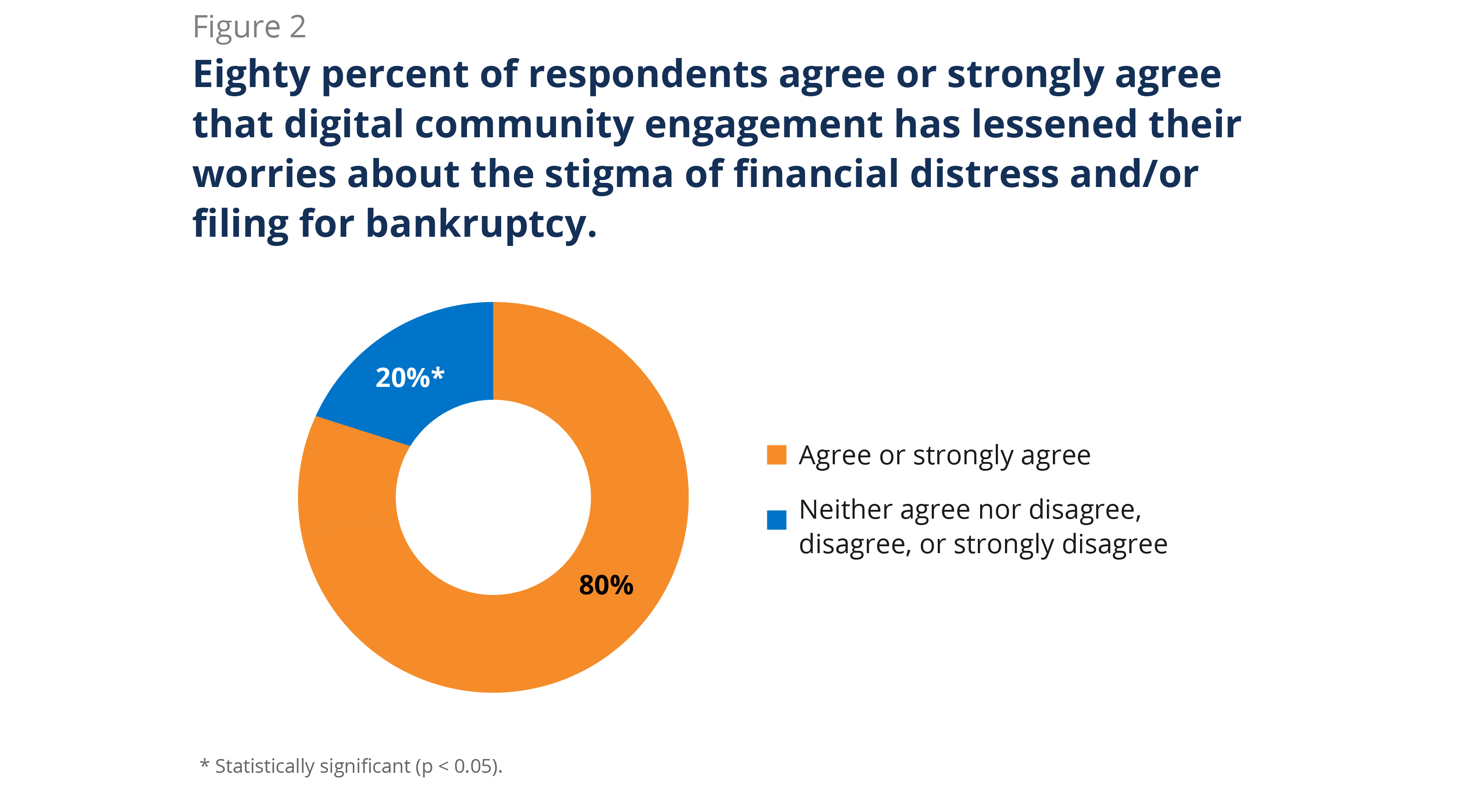How Digital Communities Can Drive Financial Decision-making and Customer Satisfaction
In collaboration with legal empowerment fintech Upsolve, we explore how incorporating a digital community into fintech tools can support user financial decision-making and improve customer satisfaction.
-
Program:
-
Category:

The Influence of Digital Community
The COVID-19 pandemic was a time of digital transformation, including the acceleration of the use of financial technology tools and the proliferation of digital communities. Throughout the pandemic, Americans used fintech apps more frequently and for a greater number of financial tasks.1 They also turned to online communities as a way to connect with others.2 To meet these evolving consumer needs, some fintech apps are combining financial tools and digital community functions, allowing users to engage with each other and connect over their personal financial experiences.
As fintech companies such as Financial Solutions Lab Accelerator portfolio company SaverLife have found, digital communities can be helpful for keeping users engaged and sourcing information about their financial health needs, challenges, and successes for research and learning purposes.3
This brief explores how participation in a digital community influences consumers’ financial decision-making and financial self-confidence, based on research conducted with users of Upsolve, a Financial Solutions Lab Accelerator portfolio company and tech platform that allows low-income people to file for bankruptcy on their own for free.
In an online survey, we asked Upsolve users about their debt, where they get their financial information, how frequently they engage with the Upsolve digital community, and whether they have filed or intend to file for bankruptcy.
This research aims to inform both fintech companies and incumbent financial services providers that may be searching for ways to increase user satisfaction and financial health through a digital community. The results from this exploratory study, while not indicative of causation, suggest benefits to both users and providers of digital communities in the financial health space.
Key Findings
Higher engagement with a digital community is correlated with:

Higher propensity to take financial action.

Higher financial confidence and self-reported well-being.

Higher satisfaction with the company providing the digital community.
Building Financial Health Through Digital Community
Many consumers want support to access information that can help them make decisions.4 Financial Health Pulse™ data show that people are more likely to receive financial advice from friends and family than from professionals.5 What’s more, consumers are beginning to seek out social connection from technology apps – Gen Z users in particular seem to want and expect a social component from fintech providers.6
Bankruptcy is an interesting test case to explore the influence of peer communities on financial decision-making and financial health for several reasons. First, bankruptcy tends to be highly stigmatized, though research shows it may be an underutilized financial health tool with significant benefits for consumers, such as preventing negative outcomes like foreclosure and civil judgments.7 Second, liquidity constraints (the inability to afford lawyers and filing fees) often prevent people from filing for bankruptcy.8 Therefore, it is important to understand how well Upsolve is performing at helping people file for free who would otherwise have been unable to afford to file for bankruptcy. Finally, racial disparities in bankruptcy are large, pervasive, and persist even when considering a host of factors, including income, assets, and the court districts where debtors live, lending urgency to the study of bankruptcy decision-making, resources, and outcomes.9,10
About Upsolve
Upsolve is a nonprofit that helps low-income families access the legal system and achieve economic mobility through free technology, education, and community. Upsolve’s tech platform helps low-income people file for bankruptcy for free, benefiting individuals who cannot afford an attorney. Since its founding in 2019, over 200,000 people have created Upsolve accounts and the company has helped relieve an estimated $450 million in debt, largely medical bills, through bankruptcy filing assistance.
The average Upsolve user earns under $20,000 per year, has $225 in their checking account, and relieves over $40,000 of debt through bankruptcy.
In 2021, Upsolve launched an online learning center and digital community designed to remove the stigma of bankruptcy and provide support to those experiencing financial hardship. Together, they reach about 2 million Americans annually. The learning center includes educational content on student loans, wage garnishment, rebuilding credit, negotiating with creditors, eviction, and other finhealth topics. Upsolve also connects users and enables peer sharing via a Facebook group and, during the time the survey was fielded, provided an internal community platform for users.
Methodology
We developed a survey asking Upsolve users questions about their debt, where they get their financial information, how frequently they engage with the Upsolve digital community, and whether they have filed or intend to file for bankruptcy. Our method for analyzing survey responses included descriptive statistics with significance testing, as well as regression analysis. We received responses from 784 users of Upsolve’s digital community. Upsolve users were screened based on whether they were members of the Upsolve Bankruptcy Community on Facebook or the Upsolver Community, both digital communities offered by Upsolve at the time, and if they engaged with either community. After screening, 459 respondents were in the final sample. Our proxies for measuring engagement included reading the news feed, making a post, commenting on a post, and liking or reacting to something in the Upsolve Bankruptcy Community Facebook group or the Upsolver Community internal news feed. Note: In reporting the results of the survey, we use the term “digital community” in the singular to refer to engagement on either of the two digital community platforms available to users.
While not designed to be a representative sample of Upsolve users, user demographics were fairly close to the demographics seen in a larger representative sample taken in 2021. Note that users who are more engaged with Upsolve’s platform may have been more inclined to complete the survey, resulting in selection bias.
Key Findings
The Upsolve digital community was designed to provide both knowledge and social support to users at different points on their bankruptcy journey with various amounts of time for engagement. Overwhelmingly, respondents who utilized the community report a beneficial impact on their financial stress and self-confidence.
To glean deeper insights from the survey response data, we explored differences between high-engagement users of the digital community and others, after controlling for factors such as bankruptcy history, income, race/ethnicity, and education.
Higher engagement with the digital community is correlated with higher propensity to take financial action.
Upsolve’s bankruptcy filing tool helps users who would not otherwise be able to afford to file for bankruptcy. The company’s digital community, meanwhile, appears to make it more likely that consumers will use Upsolve’s tool to file, indicating a way in which digital communities can complement financial services and drive consumers to take financial action that will enhance their financial health.
-
- A digital community can drive users to take major steps like filing for bankruptcy. Although users come to Upsolve’s digital community at all stages of their bankruptcy journey, data on the percentage of users who follow through with filing suggest that Upsolve helps sustain motivational momentum through what can be a complicated process.11 For example, 61% of respondents who have filed for bankruptcy say they would not have filed without engaging with Upsolve’s digital community platform.
- A digital community can reduce the need for high-cost resources. Further, 68% of those who say they wouldn’t have filed without Upsolve report that they had trouble affording an attorney to help them file, significantly more than those who stated they would have filed with or without Upsolve – demonstrating the value of Upsolve’s service and digital community in replacing the need to pay for a bankruptcy attorney.
- More-engaged users are even more likely to take action. People who frequently engage with the digital community are significantly more likely to file for bankruptcy and significantly less likely to be hesitant about bankruptcy. Respondents who engage with the community platforms multiple times per week are 13 percentage points more likely to indicate that they have filed for bankruptcy. 12 There is no significant difference between engaging one to three times per month versus once per month or less.

Users who engage more with the digital community report higher financial confidence and self-reported well-being.
Digital communities aren’t just ways for fintech companies to engage their users; study results show they also correlate with increased financial well-being for users.
-
- Digital community engagement can reduce consumer worries about the stigma of financial hardship. Though not all survey respondents were frequent users of the digital community, we found that around 80% of respondents (across engagement levels) either agreed or strongly agreed that Upsolve community engagement lessened their worries about the stigma of financial distress or filing for bankruptcy.13

-
- Connection in a digital community can also drive self-confidence. Sixty percent of all respondents either agree or strongly agree that giving advice to others boosts their self-confidence in making decisions on personal financial matters.
- Benefits to users of the digital community appear to increase as engagement becomes more frequent. Respondents who engage with the community at least once a month are 18% more likely to say they are confident in their ability to reduce their debt or remain debt-free, and 13% more likely to indicate they increased their ability to plan ahead financially, compared with people who engage once a month or less.14
- Participation in a digital community can improve emotional and mental health outcomes. Users who engaged with the platform at least once a month were 13% more likely to report improved stress and mental health, 18% more likely to indicate that they have been able to focus more on family, and 20% more likely to indicate that they have been able to prioritize joy in their lives, compared with people who engage once a month or less.15

Users who are more engaged with the digital community report higher satisfaction with the company providing it.
Greater customer satisfaction may reduce expenses and increase profitability.16 Digital community engagement can increase both customer satisfaction and retention for the fintech company providing it.
-
- Engaging with a digital community can drive customer loyalty. Those who engage regularly with the digital community are more likely to say they would recommend the fintech tool to a friend or family member. Respondents who engage with the digital community one to three times per month have on average a 0.5-point higher Net Promoter Score (on a scale of 0-10), and those who engage multiple times per week have on average a 0.7-point higher Net Promoter Score compared with those who engage once per month or less, after controlling for current bankruptcy filing, amount of time and money saved through community engagement, gender identity, and education.
- Consumers engage with a digital community for more than just transactional reasons. Eight out of 10 respondents said they check the Upsolve digital community to hear about other people’s experiences, while 20% said they check the digital community to obtain specific product or provider recommendations.
- Digital communities can benefit consumers even after they’ve already taken financial action. Providers that are considering offering a digital community may worry that once a user has obtained the information they are looking for or has taken the financial action they are considering, their engagement with the platform will end. On the contrary, we found that 68% of respondents who filed for bankruptcy say they will continue engaging with the digital community platform after filing.

Digital Communities as a Tool for Both Consumer Engagement and Finhealth
Engagement with a digital community can drive consumers to take financial action, experience increased financial satisfaction, and improve their sense of self-efficacy. This suggests the possibility of a virtuous cycle for users and fintechs: More motivated and satisfied users are more likely to engage with the platform, while engagement with the platform increases user motivation and satisfaction in turn.
While not the right financial decision for everyone, bankruptcy can provide a fresh financial start and help consumers avoid further financial hardship. Engaging with a community of peers is correlated with a higher likelihood of filing for bankruptcy and being satisfied with the bankruptcy-related service provided.
But users don’t just engage with the virtual community to take a specific finhealth action; they also search for information about alternative courses of action and products, share their own stories, and seek out experiences of others.
For banks, fintechs, and other providers that are considering incorporating a digital community into their offerings, these findings suggest that there could be benefits to doing so, both to customers and to the business.
For companies looking to explore the impact of digital community engagement, there are several avenues for future research. Future studies could apply research methods similar to the ones used here to other fintech or financial services platforms that have a large and engaged digital community, exploring what, if any, differences would be revealed using a larger sample size. Longitudinal data that follows consumers for a period of time after joining a digital community could help map where consumers get their information, as well as how impactful digital communities are in promoting longer-term satisfaction and financial health.
Acknowledgments
We are grateful to Assistant Professor of Business Administration Raymond Kluender and Research Associate Calvin Jahnke at Harvard Business School for their strategic guidance on the design of the research survey and their assistance with survey data analysis. This report also relied on participation from Upsolve’s users and input from its staff, including Chiefs of Staff Natalie Trono and Fernando Urbina, and Co-founder Rohan Pavuluri.
Many current and former Financial Health Network staff contributed to this work, including Nadia van de Walle, Marisa Walster, Meghan Greene, Michael Salmassian, Dan Miller, Maria Lajewski, Sarah Austrin-Willis, and Chris Vo.
The Financial Health Network is a trusted resource for business leaders, policymakers, and innovators united in a mission to improve the financial health of their customers, employees, and communities. Through research, advisory services, measurement tools, and opportunities for cross-sector collaboration, we advance awareness, understanding, and proven best practices in support of improved financial health for all.

The Financial Solutions Lab (FSL) was established in 2014 to cultivate, support, and scale innovative ideas that help improve financial health. FSL focuses on solutions addressing acute and persistent financial health challenges faced by low- to moderate-income individuals, Black and Latinx communities, and other underserved consumers.
The Financial Health Network manages the Financial Solutions Lab in collaboration with founding partner JPMorgan Chase and with support from Prudential Financial.
The views and opinions expressed in the report are those of the authors and do not necessarily reflect the views and opinions of JPMorgan Chase & Co., Prudential Financial, or their affiliates.
Endnotes
- “The Fintech Effect: Spotlight on COVID-19,” Plaid, 2020.
- “The Power of Virtual Communities,” TheGovLab.
- For example, see “How COVID-19 is impacting SaverLife members,” SaverLife, April 2020.
- “Many Americans, especially blacks and Hispanics, are hungry for help as they sort through information,” Pew Research Center, November 2017.
- “US Financial Health Pulse: 2020 Trends Report,” Financial Health Network, 2020.
- Svati Kirsten Narula, “What Generation Z Wants From Financial Technology,” Wall Street Journal, January 2022.
- For example, see Michelle White,, “Why Don’t More Households File for Bankruptcy?,” Journal of Law, Economics, & Organization, October 1998; Will Dobbie & Jae Song, “Debt Relief and Debtor Outcomes: Measuring the Effects of Consumer Bankruptcy Protection,” American Economic Review, March 2015.,
- Tal Gross, Matthew Notowidigdo, & Jialan Wang, “Liquidity Constraints and Consumer Bankruptcy: Evidence from Tax Rebates,” Review of Economics and Statistics, 2014.
- Paul Kiel & Hannah Fresques, “Data Analysis: Bankruptcy and Race in America,” ProPublica, September, 2017;
- Tara Siegel Bernard, “Blacks Face Bias in Bankruptcy, Study Suggests,” The New York Times, January 2012.
- Survey responses show that the Upsolve digital community serves users across a range of filing statuses: 40% of respondents have not yet filed for bankruptcy, but intend to; 46% have filed bankruptcy; and 14% are in financial distress, but don’t intend to file for bankruptcy.
- Further, respondents who engage with the community platforms multiple times per week are 14 percentage points less likely to indicate that they won’t file for bankruptcy even though they are in financial hardship, compared with people who engage with the platforms once per month or less. These differences were after we controlled for bankruptcy history, platform choice, income, race/ethnicity, and education.
- Engagement levels with the Upsolve digital community vary: 19% of respondents engage with the platform multiple times per week; 41% engage 1-3 times per month; and 38% engage once per month or less.
- After controlling for bankruptcy history, whether people get information from outside of the digital community, educational background, and attitudes such as tendency to do research before making financial decisions, preference for receiving information from peers, and valuing of experience over credentials when obtaining information.
- After controlling for the same variables noted in Footnote 14.
- David Pooser & Mark Browne, “The Effects of Customer Satisfaction on Company Profitability: Evidence From the Property and Casualty Insurance Industry,” Rock Management and Insurance Review, 2018.
Written by
How Digital Communities Can Drive Financial Decision-making and Customer Satisfaction
Explore the trends. Discover new insights. Build stronger strategies.

